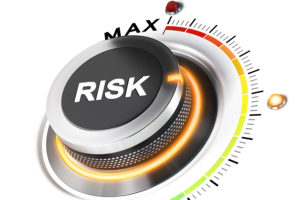Where you are on the risk tolerance scale can help you navigate volatile investing markets.
Take calculated risks. That is quite different from being rash.
Gen. George S. Patton
Risk tolerance is a constantly running theme in the investment world but also throughout life. You take a risk when you move to a new state, change jobs, change industries, start a business, start a  family, etc. All are calculated risks that often results in happy victories but can also lead to life-defining challenges and even object-lesson defeats. To not take risks is to live a life of boring stability that often leads nowhere.
family, etc. All are calculated risks that often results in happy victories but can also lead to life-defining challenges and even object-lesson defeats. To not take risks is to live a life of boring stability that often leads nowhere.
In investing, risk tolerance can be defined by many factors that when considered together will help a wise investor to make the decision necessary to ride out volatile investing markets. After the crash of 2008 and the recession that followed, many investors panicked and sold holdings to protect against further losses. In these cases one can assume that their risk tolerance was high when they initially invested but due to any number of factors they questions their capacity for risk and sought to cut their losses. For the risk tolerant investors who knew that the markets ebbed and flowed over the long run, and who perhaps understood their tolerance for risk and built their portfolio for just such an occasion, they remained long on their portfolio by the end of 2010 they had not only recovered much of their losses but also started to show modest gains.
Risk tolerance is different for each investor and the factors to be considered are:
- Age – The age you start investing will define your risk tolerance at that point. The target age you have for retirement will give you the end-point at which you and your investment advisor can determine where and when risk must be adjusted.
- Retirement goals – How much do you think you will need and how aggressive you are initially will help to choose the right investments to maximize return while weighing the risks necessary to reach the hoped-for returns.
- Who are you investing for? – Some investors invest for themselves and possibly a spouse with an eye towards retirements. Others will invest for that reason and the added reason of providing their heirs with inheritances that will help to reach their own retirement goals.
- How much are you looking to invest? – when you understand your net-worth, your existing financial needs and you plan for emergencies, you will then have a better understanding of how much you can afford to risk with the goal of building a portfolio that will serve future plans.
As the quote above points out, there is a difference between calculated risks and being rash. Calculated risks, as the terms indicates, is about taking risks when you have enough knowledge to predict best and worst case scenarios and are still comfortable taking that leap of faith. Alternatively, being rash is diving into the pool without knowing which end is the deep end and which is not. Being rash is often associated with youth and is something most level-headed people grow out of after enough stinging defeats. If you have not out-grown being rash when you start investing for the future then you need a financial advisor who will help you to learn.